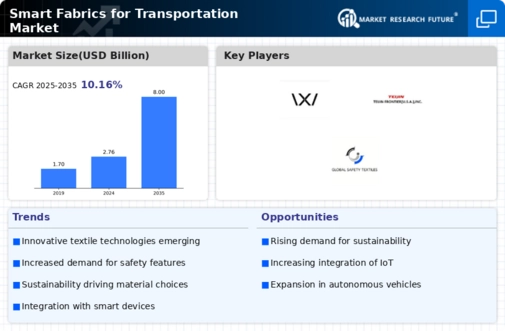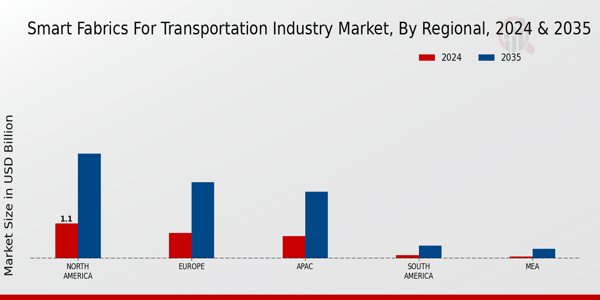Sustainability Trends
Sustainability trends are significantly influencing the Global Smart Fabrics for Transportation Market Industry. As environmental concerns rise, manufacturers are increasingly adopting eco-friendly materials and production processes. Smart fabrics that are recyclable or made from sustainable sources are gaining traction, appealing to environmentally conscious consumers and companies. For instance, the use of organic fibers and biodegradable materials in smart textiles can reduce the carbon footprint associated with transportation. This shift towards sustainability is expected to contribute to the market's growth, with a valuation of 2.76 USD Billion in 2024, indicating a growing recognition of the need for sustainable practices in the industry.
Growing Investment in R&D
Growing investment in research and development (R&D) is a key driver of the Global Smart Fabrics for Transportation Market Industry. Companies are increasingly allocating resources to explore new applications and enhance the capabilities of smart fabrics. This investment fosters innovation, leading to the development of advanced textiles that can respond to various stimuli, such as temperature changes or pressure. For instance, R&D initiatives may focus on creating fabrics that can change color based on environmental conditions. The anticipated growth of the market to 8 USD Billion by 2035 reflects the potential impact of these R&D efforts on the industry.
Market Growth Projections
The Global Smart Fabrics for Transportation Market Industry is poised for substantial growth, with projections indicating a rise from 2.76 USD Billion in 2024 to 8 USD Billion by 2035. This growth trajectory suggests a compound annual growth rate of 10.16% from 2025 to 2035, highlighting the increasing adoption of smart fabrics across various transportation applications. Factors contributing to this growth include technological advancements, heightened safety demands, and the integration of smart technologies. The market's expansion reflects a broader trend towards innovation and efficiency in the transportation sector.
Technological Advancements
The Global Smart Fabrics for Transportation Market Industry is experiencing rapid technological advancements that enhance the functionality and performance of smart fabrics. Innovations in materials science, such as the development of conductive fibers and sensors, enable fabrics to monitor environmental conditions and user health metrics. For instance, smart textiles integrated with sensors can track temperature, humidity, and even fatigue levels of drivers. This technological evolution is projected to contribute to the market's growth, with a valuation of 2.76 USD Billion in 2024 and an anticipated increase to 8 USD Billion by 2035, reflecting a compound annual growth rate of 10.16% from 2025 to 2035.
Increased Demand for Safety Features
Safety remains a paramount concern in the transportation sector, driving the Global Smart Fabrics for Transportation Market Industry. Smart fabrics equipped with safety features, such as impact sensors and alert systems, are increasingly integrated into vehicles and transportation gear. For example, fabrics that can detect collisions or sudden movements can alert drivers or passengers, potentially reducing accident rates. This heightened focus on safety is likely to propel market growth as manufacturers seek to enhance vehicle safety standards. The market's projected growth to 8 USD Billion by 2035 underscores the importance of these innovations in meeting safety demands.
Integration with IoT and Smart Technologies
The integration of smart fabrics with Internet of Things (IoT) technologies is reshaping the Global Smart Fabrics for Transportation Market Industry. This convergence allows for real-time data collection and analysis, enhancing the functionality of transportation systems. For example, smart fabrics can communicate with vehicles to provide feedback on driver performance or environmental conditions. This interconnectedness not only improves safety and efficiency but also offers valuable insights for manufacturers and consumers alike. As the market is projected to reach 8 USD Billion by 2035, the synergy between smart fabrics and IoT technologies is likely to play a crucial role in driving this growth.















Leave a Comment